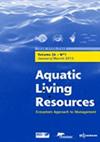Diet and food partitioning between juvenile of Epinephelus coioides (Perciformes: Epinephelidae) and other co-existing juvenile fishes in shallow waters of Thailand and Malaysia
IF 1.5
4区 农林科学
Q3 FISHERIES
引用次数: 3
Abstract
This work examined diet composition of the juvenile orange-spotted grouper, Epinephelus coioides, and its trophic association with other juvenile fish species in tropical estuarine habitats during recruitment. From December 2015 to March 2016, juveniles were collected, their stomachs excised, preserved and analyzed. Small shrimps and amphipods, especially Grandidierella sp. and Elasmopus sp., were the most common food resources sharing among the most species. Epinephelus coioides predominantly ingested small shrimp, Grandidierella sp., Elasmopus sp. and fish larvae and had the greatest trophic overlap with Palatrus scapulopunctatus. Fish size, location and month significantly affected fullness indices and food items diversity in E. coioides. It is clear that the larger the size of E. coioides and its mouth opening, the larger the size of items ingested. This study confirms the ontogenetic dietary shift of juvenile E. coioides during recruitment season by starting as amphipod and small shrimp feeder and shifting to shrimp and fish larvae predator as they grow. This finding is fundamental to understanding how juvenile E. coioides cope with different conditions and its association with other co-existing species during the recruitment period.泰国和马来西亚浅水区石斑鱼幼鱼(石斑鱼目:石斑鱼科)与其他共存幼鱼的饮食和食物分配
本研究研究了热带河口生境中幼鱼Epinephelus coioides的饮食组成及其与其他幼鱼的营养联系。从2015年12月到2016年3月,收集了幼鱼,切除了它们的胃,保存并分析。虾类和片足类,尤其是大鳞虾类和依拉丝mopus类,是最常见的食物资源共享物种。石斑鱼主要以小虾、大鳞虾、依拉斯mopus和鱼类幼虫为食,与斑马鱼有最大的营养重叠。鱼的大小、位置和月份显著影响了腹足指数和食物多样性。很明显,大肠杆菌的体型和开口越大,摄入的食物就越大。本研究证实了在捕虾季,圆齿棘蟹幼鱼从片足类动物和小虾的捕食者转变为虾和鱼幼虫的捕食者。这一发现是了解青少年的基础大肠coioides应对不同的条件及其协会在招募期间与其他物种共存。
本文章由计算机程序翻译,如有差异,请以英文原文为准。
求助全文
约1分钟内获得全文
求助全文
来源期刊

Aquatic Living Resources
农林科学-海洋与淡水生物学
CiteScore
2.30
自引率
0.00%
发文量
10
审稿时长
>24 weeks
期刊介绍:
Aquatic Living Resources publishes original research papers, review articles and propective notes dealing with all exploited (i.e. fished or farmed) living resources in marine, brackish and freshwater environments.
Priority is given to ecosystem-based approaches to the study of fishery and aquaculture social-ecological systems, including biological, ecological, economic and social dimensions.
Research on the development of interdisciplinary methods and tools which can usefully support the design, implementation and evaluation of alternative management strategies for fisheries and/or aquaculture systems at different scales is particularly welcome by the journal. This includes the exploration of scenarios and strategies for the conservation of aquatic biodiversity and research relating to the development of integrated assessment approaches aimed at ensuring sustainable and high quality uses of aquatic living resources.
文献相关原料
| 公司名称 | 产品信息 | 采购帮参考价格 |
|---|
 求助内容:
求助内容: 应助结果提醒方式:
应助结果提醒方式:


